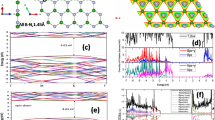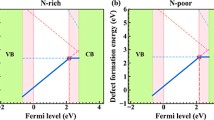Abstract
The structural and electronic properties of h-BN sheet implanted with X atoms (X = lithium (Li), beryllium (Be), aluminum (Al), carbon (C), and silicon (Si)) have been investigated to tune its band gap to amend its insulating behavior toward semiconducting material employing density functional theory (DFT). It has been observed that on replacing nitrogen or boron (N/B) atom with impurity atom, several impurity levels appear in band gap dividing big gap into small energy gaps, albeit to a different extent, depending upon the dopant element and substitutional site. The lowest value of band gap falls as low as 2.27 eV as compared to 4.63 eV of pristine h-BN in addition to the appearance of states at the Fermi level. Additionally; geometrical, interaction of foreign elements with the host material, and stability issues are discussed. These results are affable for its usage in transistor-based devices and to explore its new applications in high-power electronic and optoelectronic devices.





Similar content being viewed by others
Data availability
Data was calculated by Qurat ul Ain Asif and Akhtar Hussain.
Code availability
VASP code was provided by Akhtar Hussain.
References
Novoselov KS, Geim AK, Morozov SV, Jiang D, Zhang Y, Dubonos SV, Grigorieva IV, Firsov AA (2016) Electric field effect in atomically thin carbon films. 306(5696):666–669
Cui X, Xiao J, Wu Y, Du P, Si R, Yang H, Tian H, Li J, Zhang W, Deng D, Bao X (2016) A graphene composite material with single cobalt active sites: a highly efficient counter electrode for dye-sensitized solar cells. Angewandte Chemie - International Edition 55(23):6708–6712. https://doi.org/10.1002/anie.201602097
Asif Q ul A, Hussain A, Rafique HM, Tayyab M (2020) Computational study of Be-doped hexagonal boron nitride (h-BN): structural and electronic properties. Comput Condens Matter 23. https://doi.org/10.1016/j.cocom.2020.e00474
Chang CW, Okawa D, Majumdar A, Zettl A (2006) Solid-state thermal rectifier. Science 314(5802):1121–1124. https://doi.org/10.1126/science.1132898
Golberg D, Costa PMFJ, Lourie O, Mitome M, Bai X, Kurashima K, Zhi C, Tang C, Bando Y (2007) Direct force measurements and kinking under elastic deformation of individual multiwalled boron nitride nanotubes. Nano Lett 7(7):2146–2151. https://doi.org/10.1021/nl070863r
Kovtyukhova NI, Wang Y, Lv R, Terrones M, Crespi VH, Mallouk TE (2013) Reversible intercalation of hexagonal boron nitride with Brønsted acids. J Am Chem Soc 135:8372–8381. https://doi.org/10.1021/ja403197h
Lin Y, Williams TV, Connell JW (2010) Soluble, exfoliated hexagonal boron nitride nanosheets. J Phys Chem Lett 1(1):277–283. https://doi.org/10.1021/jz9002108
Lin Y, Williams TV, Xu TB, Cao W, Elsayed-Ali HE, Connell JW (2011) Aqueous dispersions of few-layered and monolayered hexagonal boron nitride nanosheets from sonication-assisted hydrolysis: critical role of water. J Phys Chem C 115(6):2679–2685. https://doi.org/10.1021/jp110985w
Cui Z, Oyer AJ, Glover AJ, Schniepp HC, Adamson DH (2014) Large scale thermal exfoliation and functionalization of boron nitride. Small 10(12):2352–2355. https://doi.org/10.1002/smll.201303236
Li X, Hao X, Zhao M, Wu Y, Yang J, Tian Y, Qian G (2013) Exfoliation of hexagonal boron nitride by molten hydroxides. Adv Mater 25(15):2200–2204. https://doi.org/10.1002/adma.201204031
Sainsbury T, Satti A, May P, Wang Z, McGovern I, Gun’ko YK, Coleman J (2012) Oxygen radical functionalization of boron nitride nanosheets. J Am Chem Soc. https://doi.org/10.1021/ja3080665
Lei W, Portehault D, Liu D, Qin S, Chen Y (2013) Porous boron nitride nanosheets for effective water cleaning. Nat Commun 4. https://doi.org/10.1038/ncomms2818
Maiti UN, Lee WJ, Lee JM, Oh Y, Kim JY, Kim JE, Shim J, Han TH, Kim SO (2014) 25th anniversary article: chemically modified/doped carbon nanotubes & graphene for optimized nanostructures & nanodevices. Adv Mater. https://doi.org/10.1002/adma.201303265
Kaewmaraya T, Srepusharawoot P, Hussian T, Amornkitbamrung V (2017) Electronic properties of h-BCN–blue phosphorene van der Waals heterostructures. ChemPhysChem 19(5):612–618. https://doi.org/10.1002/cphc.201701150
Kim M, Moon SW, Kim G, Yoon SI, Kim K, Min SK, Shin HS (2020) Effect of Pt crystal surface on hydrogenation of monolayer h-BN and its conversion to graphene. Chem Mater 32:4584–4590. https://doi.org/10.1021/acs.chemmater.0c00736
Späth F, Steinhauer J, Düll F, Bauer U, Bachmann P, Steinrück HP, Papp C (2020) Reaction of hydrogen and oxygen on h-BN. J Phys Chem C 124:18141–18146. https://doi.org/10.1021/acs.jpcc.0c05299
Sun C, Ma F, Cai L, Wang A, Wu Y, Zhao M, Yan W, Hao X (2017) Metal-free ternary BCN nanosheets with synergetic effect of band gap engineering and magnetic properties. Sci Rep 7(1). https://doi.org/10.1038/s41598-017-07143-6
Gautam C, Tiwary CS, Jose S, Brunetto G, Ozden S, Vinod S, Raghavan P, Biradar S, Galvao DS, Ajayan PM (2015) Synthesis of low-density, carbon-doped, porous hexagonal boron nitride solids. ACS Nano 9:12088–12095. https://doi.org/10.1021/acsnano.5b05847
Sagynbaeva M, Hussain T, Panigrahi P, Johansson B, Ahuja R (2015) Complementing the adsorption energies of CO2, H2S and NO2 to h-BN sheets by doping with carbon. EPL 109(5). https://doi.org/10.1209/0295-5075/109/57008
Singh RS, Tay RY, Chow WL, Tsang SH, Mallick G, Teo EHT (2014) Band gap effects of hexagonal boron nitride using oxygen plasma. Appl Phys Lett 104:163101. https://doi.org/10.1063/1.4872318
Zhao G, Wang A, He W, Xing Y, Xu X (2019) 2D new nonmetal photocatalyst of sulfur-doped h-BN nanosheeets with high photocatalytic activity. Adv Mater Interfaces 6(7). https://doi.org/10.1002/admi.201900062
Kökten H, Erkoç Ş (2014) A study on Si and P doped h-BN sheets: DFT calculations, Turkish. J Phys 38:369–374. https://doi.org/10.3906/fiz-1406-17
Majety S, Doan TC, Li J, Lin JY, Jiang HX (2013) Electrical transport properties of Si-doped hexagonal boron nitride epilayers. AIP Adv 3:122116. https://doi.org/10.1063/1.4860949
Sun F, Hao Z, Liu G, Wu C, Lu S, Huang S, Liu C, Hong Q, Chen X, Cai D, Kang J (2018) P-Type conductivity of hexagonal boron nitride as a dielectrically tunable monolayer: modulation doping with magnesium. Nanoscale 10:4361–4369. https://doi.org/10.1039/c7nr08035b
Hussain A, Ullah S, Farhan MA (2016) Fine tuning the band-gap of graphene by atomic and molecular doping: a density functional theory study. RSC Adv 6:55990–56003. https://doi.org/10.1039/c6ra04782c
Hussain A, Tayyab M (2020) Effect of Cu concentration and dopant site on the band gap of MoS2: A DFT study. Comput Condens Matter 24. https://doi.org/10.1016/j.cocom.2020.e00494
Tarasov A, Zhang S, Tsai MY, Campbell PM, Graham S, Barlow S, Marder SR, Vogel EM (2015) Controlled doping of large-area trilayer MoS2 with molecular reductants and oxidants. Adv Mater 27:1175–1181. https://doi.org/10.1002/adma.201404578
Ristein J (2006) Surface transfer doping of semiconductors. Science 313:1057–1058. https://doi.org/10.1126/science.1127589
Liu H, Liu Y, Zhu D (2011) Chemical doping of graphene. J Mater Chem 21:3335–3345. https://doi.org/10.1039/c0jm02922j
Chen W, Qi D, Gao X, Wee ATS (2009) Surface transfer doping of semiconductors. Prog Surf Sci 84:279–321. https://doi.org/10.1016/j.progsurf.2009.06.002
Kresse G, Hafner J (1994) Ab initio molecular-dynamics simulation of the liquid-metalamorphous- semiconductor transition in germanium. Phys Rev B 49:14251–14269. https://doi.org/10.1103/PhysRevB.49.14251
Blöchl PE (1994) Projector augmented-wave method. Phys Rev B 50:17953
Perdew JP, Burke K, Ernzerhof M (1996) Generalized gradient approximation made simple. Phys Rev Lett. https://doi.org/10.1103/PhysRevLett.77.3865
Monkhorst HJ, Pack JD (1976) Special points for Brillouin-zone integrations. Phys Rev B. https://doi.org/10.1103/PhysRevB.13.5188
Ullah S, Hussain A, Sato F (2017) Rectangular and hexagonal doping of graphene with B, N, and O: a DFT study. RSC Adv 7:16064–16068. https://doi.org/10.1039/c6ra28837e
Asif Q ul A, Hussain A, Nabi A, Tayyab M, Rafique HM (2021) Computational study of X-doped hexagonal boron nitride (h-BN): structural and electronic properties (X = P, S, O, F, Cl). J Mol Model 27(2). https://doi.org/10.1007/s00894-020-04659-z
Liu YJ, Gao B, Xu D, Wang HM, Zhao JX (2014) Theoretical study on Si-doped hexagonal boron nitride (h-BN) sheet: electronic, magnetic properties, and reactivity. Phys Lett Sect A Gen At Solid State Phys 378:2989–2994. https://doi.org/10.1016/j.physleta.2014.07.053
Paszkowicz W, Pelka JB, Knapp M, Szyszko T, Podsiadlo S (2002) Lattice parameters and anisotropic thermal expansion of hexagonal boron nitride in the 10–297.5 K temperature range. Appl Phys A Mater Sci Process. https://doi.org/10.1007/s003390100999
Kim D-H, Kim H-S, Song MW, Lee S, Lee SY (2017) Geometric and electronic structures of monolayer hexagonal boron nitride with multi-vacancy. Nano Converg. https://doi.org/10.1186/s40580-017-0107-0
Zhou J, Wang Q, Sun Q, Jena P (2010) Electronic and magnetic properties of a BN sheet decorated with hydrogen and fluorine. Phys Rev B - Condens Matter Mater Phys. https://doi.org/10.1103/PhysRevB.81.085442
Zhou YG, Xiao-Dong J, Wang ZG, Xiao HY, Gao F, Zu XT (2010) Electronic and magnetic properties of metal-doped BN sheet: a first-principles study. Phys Chem Chem Phys. https://doi.org/10.1039/b918183k
Naqvi SR, Rao GS, Luo W, Ahuja R, Hussain T (2017) Hexagonal boron nitride (h-BN) sheets decorated with OLi, ONa, and Li2F molecules for enhanced energy storage. ChemPhysChem 18:513–518. https://doi.org/10.1002/cphc.201601063
Momma K, Izumi F (2008) VESTA: A three-dimensional visualization system for electronic and structural analysis. J Appl Crystallogr 41:653–658. https://doi.org/10.1107/S0021889808012016
Marezio M, Remeika JP, Dernier PD (1970) The crystal chemistry of the rare earth orthoferrites, Acta Crystallogr. Sect B Struct Crystallogr Cryst Chem 26:2008–2022. https://doi.org/10.1107/s0567740870005319
Topsakal M, Aktürk E, Ciraci S (2009) First-principles study of two- and one-dimensional honeycomb structures of boron nitride. Phys Rev B - Condens Matter Mater Phys. https://doi.org/10.1103/PhysRevB.79.115442
He B, Zhang WJ, Yao ZQ, Chong YM, Yang Y, Ye Q, Pan XJ, Zapien JA, Bello I, Lee ST, Gerhards I, Zutz H, Hofsäss H (2009) P -type conduction in beryllium-implanted hexagonal boron nitride films. Appl Phys Lett 95:2–5. https://doi.org/10.1063/1.3276065
Yu S, Li L, Lai Z, Hao J, Zhang K (2017) A coupling effects of vacancy and Al (Ga, In) dopant on electronic structures of hexagonal boron nitride monolayer. Mater Res Express. https://doi.org/10.1088/2053-1591/aa93bf
Fujimoto Y (2017) Formation and physical properties of h-BN atomic layers: a first-principles density-functional study. Adv Mater Sci Eng. https://doi.org/10.1155/2017/2676432
Mapasha RE, Igumbor E, Chett N (2016) A hybrid density functional study of silicon and phosphorus doped hexagonal boron nitride monolayer. J Phys Conf Ser 759:012042. https://doi.org/10.1088/1742-6596/759/1/012042
Ullah S, Hussain A, Syed WA, Saqlain MA, Ahmad I, Leenaerts O, Karim A (2015) Band-gap tuning of graphene by Be doping and Be, B co-doping: a DFT study. RSC Adv 5:55762–55773. https://doi.org/10.1039/c5ra08061d
Zhang L, Gao YC (2017) Electronic structures, magnetic properties and half-metallicity in the Heusler alloy Hf2VAl, Chinese. J Phys 55:1466–1472. https://doi.org/10.1016/j.cjph.2017.04.012
Acknowledgments
The authors would like to thank the substantial support by PINSTECH; Government College University, Faisalabad, Punjab, Pakistan, and the University of the Punjab, Lahore, Pakistan. Special thanks to Haris Akram Bhatti for fruitful discussions.
Author information
Authors and Affiliations
Contributions
Qurat ul Ain Asif gave the main idea, drafted the manuscript, prepared, and calculated the data; Akhtar Hussain provided the VASP code, calculated the data, and reviewed the manuscript carefully; Muhammad Kashif and Muhammad Tayyab helped in plotting of results; Hafiz Muhammad Rafique provided guidance and helped in defining the results.
Corresponding authors
Ethics declarations
Conflict of interest
The authors declare no competing interest.
Additional information
Publisher's note
Springer Nature remains neutral with regard to jurisdictional claims in published maps and institutional affiliations.
Rights and permissions
About this article
Cite this article
Asif, Q.u.A., Hussain, A., Kashif, M. et al. Computational study of electronic properties of X-doped hexagonal boron nitride (h-BN): X = (Li, Be, Al, C, Si). J Mol Model 27, 319 (2021). https://doi.org/10.1007/s00894-021-04938-3
Received:
Accepted:
Published:
DOI: https://doi.org/10.1007/s00894-021-04938-3




